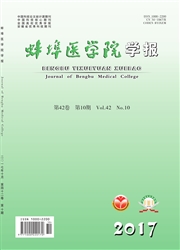

 中文摘要:
中文摘要:
目的:观察青春期至成年早期小鼠经饮水暴露铅和镉对肝脏和肾脏功能的影响。方法:健康4周龄雄性ICR小鼠60只,随机分为对照组、铅组、镉组、铅+镉组,各15只。4组小鼠分别经口饮用纯净水、醋酸铅水溶液、氯化镉水溶液和醋酸铅+氯化镉混合水溶液,暴露40 d后摘眼球取血,处死小鼠后取肝脏和肾脏,称脏器质量,计算脏器系数,检测血清丙氨酸氨基转移酶(ALT)与碱性磷酸酶(ALP)活力以及血清肌酐(Cr)和尿素氮(BUN)含量,用HE染色观察肝脏和肾脏组织形态学改变。结果:对照组、镉组和铅+镉组小鼠的每日饮水量均少于铅组(P〈0.05~P〈0.01),铅组和镉组小鼠每日进食量均少于对照组和铅+镉组(P〈0.05~P〈0.01),而4组小鼠4~10周龄体质量差异均无统计学意义(P〉0.05)。连续暴露40 d后,均未引起铅、镉组和铅+镉组小鼠体质量、肝脏质量、肝脏系数、血清ALT和ALP活力以及肝脏组织形态学改变。镉+铅组小鼠肾脏质量低于单纯镉组(P〈0.05),但铅组、镉组和铅+镉组小鼠肾脏质量、肾脏组织形态学、血清Cr和BUN含量与对照组差异均无统计学意义(P〉0.05)。结论:青春期和成年早期经饮水暴露一定剂量铅与镉均未引起雄性小鼠肝脏和肾脏功能损害。
 英文摘要:
英文摘要:
Objective:To observe the effects of the co-exposure of lead and cadmium during drinking water from puberty to early adulthood on the hepatic and renal function in male mice. Methods:Sixty healthy male ICR mice with 4 weeks old were randomly divided into the control group,lead group,cadmium group,and lead & cadmium group(15 mice each group). The control group,lead group,cadmium group,and lead&cadmium group were bred using the pure water,lead acetate solution,cadmium chloride solution,and mixture solution of lead acetate with cadmium chloride by oral, respectively. After 40 days of exposure, the blood was collected by removing eyeballs. The weight of liver and kidney were calculated for obtaining the organ coefficient after the mouse was sacrificed. The serum alanine aminotransferase( ALT) and alkaline phosphatase( ALP) activities,and serum creatinine( Cr) and urea nitrogen( BUN) content were detected,the histological morphology of liver and kidney was evaluated using H&E staining. Results:The daily water intake in control group,cadmium group and lead & cadmium group were lower than that in lead group(P〈0. 05 to P〈0. 01),and the daily diet intake in lead group and cadmium group were lower than that in control group and cadmium& lead group(P〈0. 05 to P〈0. 01), and the differences of body weight between four groups with 4 to 10 weeks old were not statistically significant(P〉0. 05). After 40 days of exposure, the differences of the body weight, liver weight, liver coefficient, serum ALT and ALP activities, and liver histological morphology in lead group,cadmium group and lead & cadmium group were not identified. The kidney weight in lead & cadmium group was lower than that in cadmium group(P 〈0. 05),but compared with the control group,the differences of the kidney weight,liver histological morphology and serum Cr and BUN content between the control group,and the lead group,cadmium group and lead & cadmium group were not statistically signif
 同期刊论文项目
同期刊论文项目
 同项目期刊论文
同项目期刊论文
 期刊信息
期刊信息
